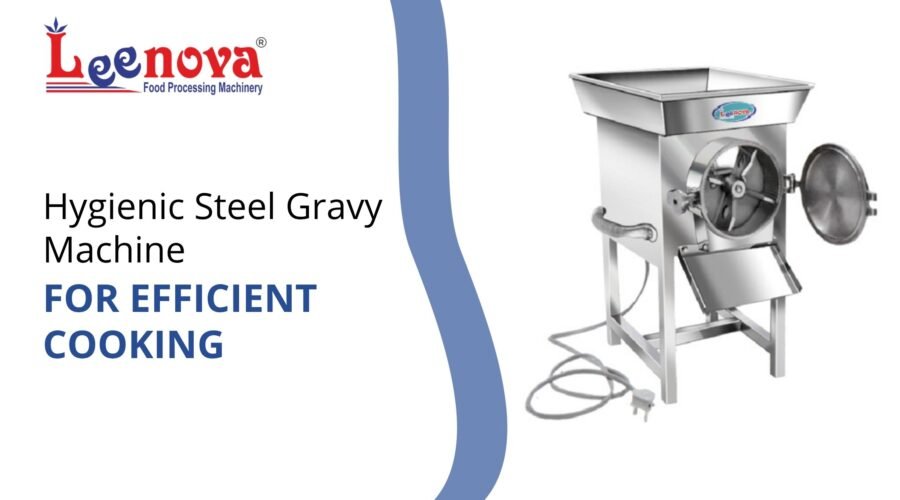Commercial kitchens waste up to 40% of their prep time on manual grinding tasks. The repetitive strain of crushing onions, garlic, and tomatoes slows output and increases labor costs. A hygienic steel gravy machine automates this bottleneck, delivering consistent texture in seconds while maintaining food safety standards. This guide walks through features, applications, hygiene protocols, and selection criteria to help restaurant owners, caterers, and food processors make an informed purchase decision.
Features of Hygienic Steel Gravy Machines
Premium-Grade Stainless Steel Construction
Food-grade stainless steel resists corrosion from acidic ingredients like tomatoes and tamarind. The non-reactive surface prevents metallic taste transfer, keeping gravies true to the recipe. Welded joints eliminate crevices where bacteria hide, and polished finishes make post-shift cleaning a quick wipe-down.
Powerful Motor and Precision Blades
Motors ranging from 2HP to 5HP handle different volumes. A 2HP single-phase unit processes 35-50 kg per hour—enough for mid-sized restaurants. Three-phase motors scale to catering operations grinding boiled onions, ginger-garlic pastes, and nut-based masalas. Blades rotate at 1440-2880 RPM, creating smooth consistency without over-heating ingredients.
Compact Design with Safety Features
Grinding chambers measure 6-7 inches in diameter, fitting under standard counter heights. Overload protection prevents motor burnout during dense loads. Stainless steel jali (mesh) strainers filter fibrous residue, ensuring uniform texture. Most units weigh 35-60 kg—stable during operation yet movable for deep cleaning.
Technical Specifications and Capacity
Capacity dictates throughput. Entry-level 2HP models grind 12-15 kg/hour for dhabas and small caterers. Mid-range 3HP versions reach 40-50 kg/hour, suitable for hotels serving 200+ covers daily. High-output 5HP machines process 80-100 kg/hour for banquet kitchens and food processing units.
Motor options split between single-phase (220-240V) for general use and three-phase for continuous commercial loads. Chamber dimensions vary: a 6″x3″ chamber suits smaller batches; 7″x3″ handles bulk prep. Warranty coverage typically includes one year on motors, signaling manufacturer confidence in durability.
Benefits for Kitchen Efficiency
Manual grinding takes 10-15 minutes per kilogram. Machines reduce this to under two minutes, freeing staff for plating and customer service. Consistent texture eliminates the guesswork—every batch matches the last, crucial for chain restaurants maintaining brand standards.
Energy-efficient designs consume 1-2 units per hour, offsetting initial investment through lower utility bills. Automation cuts labor dependency, addressing high turnover in kitchen roles. The compact footprint saves floor space in cramped prep areas, a premium in urban kitchens.
Applications and Usage
These machines grind wet ingredients with high water content. Tomatoes, onions, ginger, garlic, green chilies, coriander, mint, palak (spinach), beetroot, and karela (bitter gourd) all convert to smooth pastes. Boiled legumes for dal, soaked cashews for korma bases, and hydrated chilies for red sauces pass through effortlessly.
Restaurants use them for curry bases, chutneys, and marinades. Caterers prep bulk quantities for weddings and corporate events. Food processing units bottle gravies and pastes for retail. The versatility spans Indian, continental, and fusion cuisines.
Hygiene and Food Safety
Stainless steel meets food-grade certifications like ISO 9001:2015, mandatory for commercial operations. Removable grinding chambers and jali strainers disassemble without tools, enabling thorough sanitization between batches. Sealed motor housings prevent liquid ingress, reducing contamination risk.
Minimal human contact lowers bacterial transmission. Ingredients go in; paste comes out—no repeated handling. Daily cleaning involves rinsing chambers with warm water and food-safe detergent, then air-drying. Monthly deep cleans with descaling agents maintain performance and extend equipment life.
Comparison with Manual Grinding Methods
Hand-ground pastes lack uniformity. Stones or mixies miss fibrous chunks, creating gritty textures. Machines pulverize ingredients at high speed, breaking cell walls for smoother emulsions. The difference is stark in onion gravies—machine-ground bases integrate seamlessly, while manual versions separate.
Speed matters during rush hours. A cook grinds two kilograms manually in 20 minutes. The same load takes four minutes in a gravy machine, cutting prep time 80%. Labor savings compound over months—one machine replaces half a prep assistant’s workload.
Waste drops when grinding is efficient. Manual methods leave residue stuck to stones; machines extract 95%+ yield. Over a year, reduced waste offsets equipment cost for mid-sized operations.
Why Choose This Equipment?
CE and ISO certifications validate quality. Established manufacturers offer dealer networks for parts and service, critical in tier-2 and tier-3 cities. Competitive pricing—entry units start around ₹12,000, premium models reach ₹40,000—fits budgets from startups to chains.
Customization options include voltage adjustments for regional power grids and chamber sizes for specific recipes. After-sales support includes installation guidance, operator training, and responsive troubleshooting. These factors differentiate reliable suppliers from transactional vendors.
Frequently Asked Questions
Q: Can this machine grind dry spices?
A: No. Gravy machines handle wet ingredients only. Dry grinding requires a pulverizer with different blade geometry and chamber design. Using the wrong machine damages motors and voids warranties.
Q: How often should blades be replaced?
A: Blades last 18-24 months under normal use. Signs of wear include inconsistent texture, increased grinding time, and unusual vibrations. Replacing blades costs ₹1,500-₹3,000 depending on model.
Q: Is single-phase or three-phase better?
A: Single-phase suits restaurants with standard electrical connections. Three-phase handles continuous operation without overheating, ideal for caterers and processors running 8+ hour shifts.
Q: What maintenance prevents breakdowns?
A: Lubricate motor bearings every six months. Check electrical connections for corrosion. Clean the grinding chamber daily. These simple steps prevent 80% of service calls.
Conclusion
Investing in a hygienic steel gravy machine transforms kitchen productivity. The time saved, consistency gained, and labor costs reduced justify the upfront expense within months for most commercial operations.
Leenova Kitchen Equipments manufactures CE-certified, ISO 9001:2015 compliant gravy machines designed for commercial reliability. With 17+ years of food machinery experience and a product range covering 2HP to 5HP models, the company delivers factory-direct pricing, one-year motor warranties, and nationwide dealer support. Ready to upgrade the prep line? Contact the team for model selection guidance and bulk pricing.


